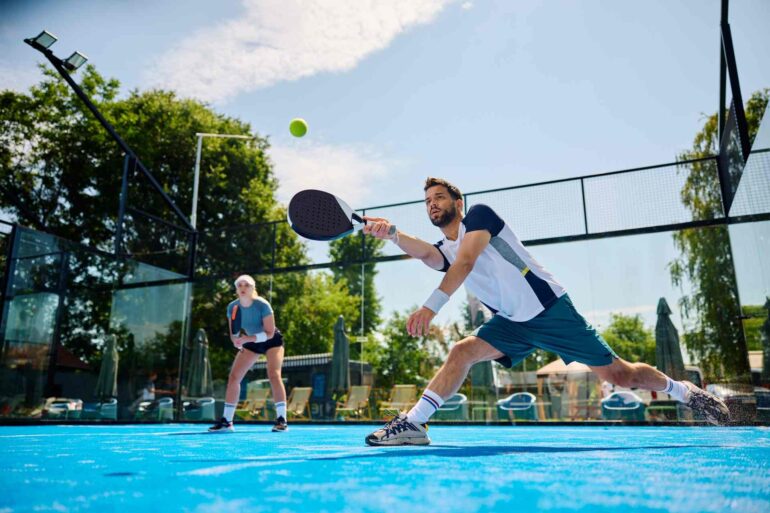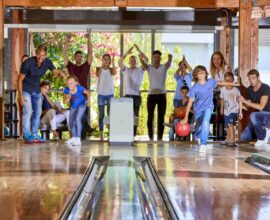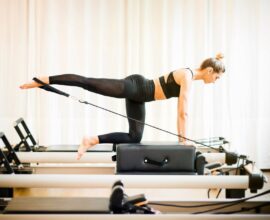Padel game: moves and shots that every player must know
All the secrets to dominate the padel court and achieve a win
Serve, forehand, backhand, bandeja and volèe are only some of the main padel moves and shots that a padel player must learn to handle to bring the game to the next level.
Fun, dynamic and adrenaline-filled, suitable for people of different ages and levels of physical shape, and for those who want to approach racket sports for the first time (the rules are few and simple to learn), padel – a fusion of tennis, racquetball and squash – has quickly become one of the most loved and trendy sports, and it’s not difficult to understand why.
The small size of the court, especially compared to tennis’s, and the possibility of taking advantage of wall rebounds, generally made of tempered glass or any other transparent material, which allows to see the action from the outside, make each match engaging and unpredictable, keeping a high pace and offering an ever stimulating challenge even for the most experienced players.
The particular rackets design also helps make the game so accessible, lighter than tennis ones because they don’t have strings and are characterized by a solid surface with holes, for better ball control and a rather reduced impact on joints. Not to mention all the physical benefits of padel, excellent for achieving your physical goals while having fun, but also for challenging your limits and rediscovering that healthy spirit of competition that is key for a more satisfying life.
Game after game, players have the opportunity to improve their performance, learn from others and spend a few hours in company. It is a sport mainly played in doubles indeed (although you can also try singles, still quite challenging especially for beginners), given its extremely dynamic nature, adding a social dimension to the competition. To be successful in padel, it is important to develop good communication with your team mate, in order to coordinate and effectively anticipate next actions.
At the same time, to win a padel game it’s not enough to leverage on speed and quick reflexes, but it’s essential to master the main moves and shots, which are 8 between attack and defense. Each of these plays a crucial role to determine the outcome of a rally, from the serve accuracy to the tactical handling of the volée, up to the defense with the bandeja and the power of the backhand, therefore is key to perfect them all to better control the game, making pressure to opponents and taking advantage of every chance to score the point.
Padel game: 8 key moves and shots to play like a professional
In the fascinating world of padel, success much depends on contenders speed and agility, but also on the mastery of a series of strategic moves and shots that can change any match, even those that seem to have the most certain outcome.
Each serve, whether is a powerful attack or a strategic defense, plays a key role determining the game pace and putting pressure on the opponent. In addition to the serve, forehand and backhand, the easiest to learn, padel has a series of essential shots that every player should know to make their playing style more complete and effective. Among these, volée and smash (known as “remate” in Spanish) some of the most used in a match, but also bandeja, vibora and the globo (lob), all terms of Spanish origin that highlight the origins of this sport, born between Spain and South America in the late 1960’s.
Learning and mastering each of these moves and shots enriches technical knowledge, and allows to face different game situations with greater confidence and strategy, both for beginners or more advanced players.
1. Serve
The serve is the initial shot that starts each rally in padel, and is performed by throwing and hitting the ball with the racket while it’s on the way down. Unlike tennis, the padel service must be performed from below, requiring a lot of practice and good technical basics.
To make an effective serve, it’s important to position yourself correctly behind the service line, maintaining an adequate distance from the net and keep your feet slightly apart. During the motion, it is important to throw the ball with one hand and hit it with the other at the top of the throw to get top power and precision.
Useful tips
Alternating the type of serve between flat, top-spin or slice shots make it more difficult for the opponents to respond, and varying its direction, hitting to different areas of the court, forces them to move and be ready for different shots.
2. Forehand
As the name suggests, a forehand is a shot made with the front of the racket usually used when the ball comes from the dominant side of the body. It is the most powerful and direct shot and one of the main offensive moves.
To make an effective forehand, maintain a good starting position, with your feet planted and shoulders parallel to the net, while preparing the shot. In the movement, rotate your torso and shift the weight from back to front, hitting the ball at hip height to maximize power.
It’s important to consider that the racket’s angle at impact determines the direction of the ball; a tighter angle produces higher shots, while a wider angle makes flatter and faster shots.
Useful tips
For an effective forehand, it’s advisable to vary serve’s intensity and direction, using angled or deep shots to push pressure on your opponent and create chances to achieve the point. To improve your forehand technique, practicing footwork exercises can help, focusing on position, coordination and timing.
3. Backhand
Unlike the forehand, the backhand is typically used to return shots from the non-dominant body side. From a strategic perspective, it can surprise the opponent, especially if you work on varying shots power and direction.
Although it may seem more complex than forehand (it can be hit with one or two hands), this shot offers numerous offensive and defensive opportunities, making it a key element to win in a match.
Again, the racket angle at impact affects the trajectory of the ball: a tighter angle produces a deeper, more controlled shot, while a wider angle generates higher, more angled shots. A very important aspect is the communication with your team mate, as playing doubles is key to coordinate defense and attack moves.
Useful tips
Performing backhand, rotate your body to generate as much power as possible, shifting your weight from the back leg to the front leg as you swing. The shot must be done in a wide arc, hitting the ball at body height or slightly below, in order to enhance effectiveness.
4. Smash (Remate)
The smash is one of the most spectacular and effective padel moves, performed by jumping, hitting the ball from high to low. Strategically, the smash is excellent to surprise opponents and get the point, especially after forcing them to play a weak shot or a low volée. Anyway, it is relevant to avoid performing a smash when they’re in good position, since a poorly placed shot could provide the chance for a counterattack.
From a technical point of view, this shot is performed when the ball is high and allows the player to hit it from high to low, generating notable power and speed. The correct technique to make a smash entails rotating torso and placing the weight on the back leg, then moving it forward at impact. The racket must be moved above the head in a wide arc, and the shot must be closed with a firm and controlled movement, striking the ball at the highest point.
The smash direction is also crucial: a well-done shot must go downwards, aiming to hit the ground near the net and giving no chance for the opponent to respond properly.
Useful tips
Timing and position are key to jump at the right moment. To improve your technique, it is advisable to practice in real game situations, learning to anticipate opponent’s moves and correctly read the game strategy.
5. Volée
The volée is a shot performed without bouncing the ball on the ground, hitting it in flight and mainly used at the net to counter an opponent’s attack taking control of the rally. This shot is particularly effective in surprising opponents, as it reduces the reaction time and puts pressure on the players on the other side of the court.
From a strategic point of view, volée is useful in both offensive and defensive situations. In the offensive phase, it allows to achieve the point quickly, while in defense it can be used to respond to powerful or angled shots. A good volée also creates chances for following shots, such as a smash, by exploiting the opponent’s position.
The starting position is key: the player must keep a stable posture, with feet firmly planted on the ground and body ready to move quickly in different directions. When performing volée, the racket must be kept front of the body, and the follow-through action should be controlled while hitting the ball, as the angle of the strike determines the shot direction: a downward-angled shot makes a depth effect, while a horizontal shot creates a wider angle, making it difficult for the opponent to recover.
Useful tips
Practicing volée both forehand and backhand increases your versatility at the net. It’s also essential to maintain good communication in doubles games, as volée requires coordination and foresight to avoid overlap or confusion.
6. Bandeja
The bandeja (“the tray”, since the racket is held with a motion similar to someone carrying a tray) is a defensive shot made in a cutting motion, generally used when the ball is still high, in order to keep control of the rally without forcing the shot too much.
Unlike the smash, the bandeja is not performed to get the point with power, but to return the ball in a more controlled way, keeping the opponent away from the net and preparing for the next rally. It aims to slow down the game pace and maintain more control, preventing the opponent from immediately counterattacking.
From a technical point of view, it is important to focus on two aspects: the body positioning and the shot fluidity. The weight must be shifted forward at impact, and the racket must follow a controlled arc to ensure a precise trajectory. The risk of hitting a too strong bandeja entails that the ball bounces high, giving chance to the opponents to make a smash or a powerful forehand shot.
Useful tips
For a correct bandeja, the player must position right under the ball, keeping body balanced and the racket above head in a waiting position. The motion must be slow and controlled, with a shot that gives ball a low and deep direction, especially towards the court’s corners. The aim is to bounce the ball against the opponent’s court back walls, making it difficult to recover it effectively.
7. Vibora
The vibora is one of the most aggressive and technically hard padel moves, considered a more offensive variant of bandeja. Its name comes from the movement resembling a snake bite, as it is performed with a cutting effect, fast and angled, difficult to be predicted and responded effectively.
This shot is mainly used when the player is close to the net and must handle a high ball to put pressure on the opponent without risking. Technically, the vibora is made by hitting the ball from above, with a motion starting from the outside and rotating towards the inside, giving a lateral effect that causes the ball to drop quickly after the bounce.
Unlike bandeja, which has a defensive use and aims to return the ball in control and depth, the vibora is used to attack aggressively, creating trajectories difficult to be intercepted, as the ball tends to fly off laterally or bounce unpredictably after touching the walls.
From a tactical perspective, it is indeed very useful for achieving the point or for putting more pressure, forcing opponents to respond with a defensive shot or make a mistake. However, this shot requires precision and control: if not performed correctly, it can result in an error and so a ball for an easy counterattack.
Useful tips
The racket motion must be quick and fluid, with the wrist rotating inward at contact to generate the lateral effect. For a good impact you must give the ball a low and cut trajectory, preferably towards opponent’s court corners, trying to make the ball bounce against the walls and make it hard to respond.
8. Globo (Lob)
The globo (or lob) is primarily used to gain time and recover good position, especially when under pressure or facing a tricky situation near the net.
This key shot involves sending the ball high and deep towards the opponent’s court, aiming to force the opponents away from the net, where they have a greater advantage, towards the back of the game area. The lob is also useful as a tactical move to break the pace of the opponent: while many players try to keep control near the net with fast and aggressive shots, a well-placed globo can interrupt this tactic, giving time to the defensive player to reposition and take control. In a game situation where the opponent’s pressure is high, the lob allows the player to “breathe”, bringing the game back to a more neutral ground.
However, if not performed correctly, it can be a rather risky shot: a too low globo in fact risks leaving the opponent in position to hit a decisive smash. Therefore, it is important to perfect the shot height and depth to avoid giving away an opportunity to the opponent.
Useful tips
To perform an effective lob, the player must hit the ball with a low-to-high motion, trying to create an effect that makes it rise regularly and precisely. The ideal shot is high enough to easily move over opponent’s head, but not too deep to end up beyond the court’s baseline, thus avoiding a mistake that could cost the point. It is important to give ball a controlled effect, to avoid it bouncing quickly or giving an easy chance for a smash in response.
Knowing how to master these eight padel moves and shots is key to improve performance and challenge one’s limits, increasing fun and competitiveness of matches. In this sense, the Padel Academy by Forte Village offers the best environment to refine your skills on the court and enjoy a stimulating and engaging gaming experience.
Padel Academy: the sport facility dedicated to future padel champions by Forte Village
Learning to master the eight fundamental padel moves ad shots and improving your technique and strategy together with legends of the discipline, such as Spanish multiple world champion Bebe Hernan Auguste, No. 1 in the international ranking for four consecutive years (in 1997, 1998, 1999 and 2000), is now possible at the exclusive Forte Village Padel Academy.
This is one of the most beloved sports academies in Forte Village, the renowned five-star resort that, thanks to its privileged position next to the most beautiful beaches in Sardinia and the amazing natural biodiversity hosted in over 50 hectares of lush nature surrounding it, for years has been a true paradise for lovers of sport and adventure.
On the Academy’s well-equipped padel court, open from mid-May to early November, adults and children can take their first steps with the fundamental moves and shots of this dynamic and fun sport, consolidate progresses made and refine their technique in group or individual lessons, structured according to specific needs and purposes. An interesting possibility refers to the use of the facility to have fun with friends and challenge them to the last set.
For further information, please phone call to the number +390709218818 or write an email to holiday@fortevillage.com.
Do you want to master the eight fundamental padel moves and shots and experience a fairytale holiday in an authentic paradise? Discover Forte Village Resort in Sardinia






